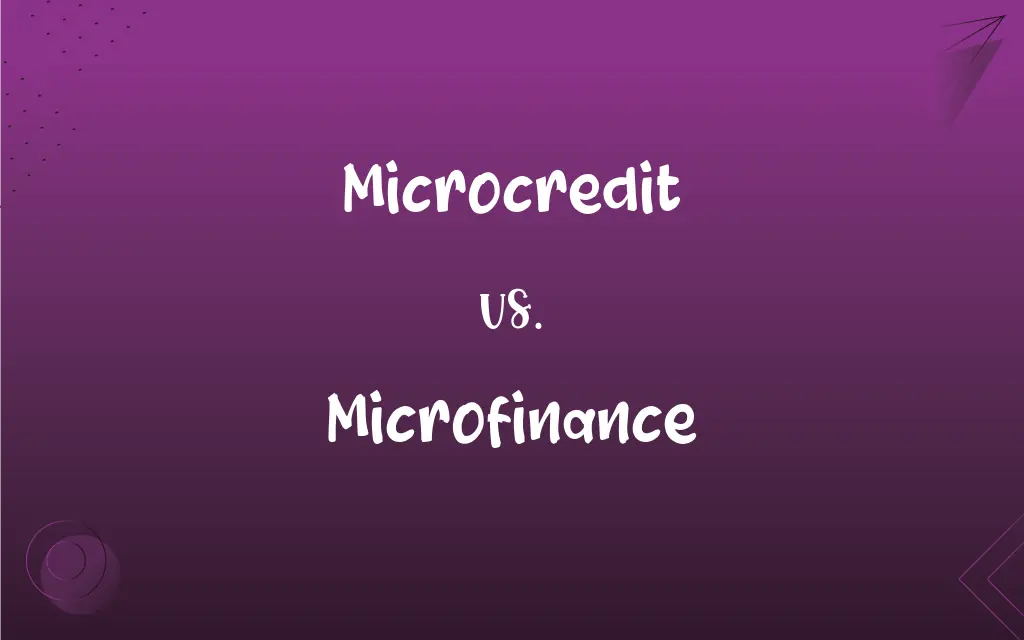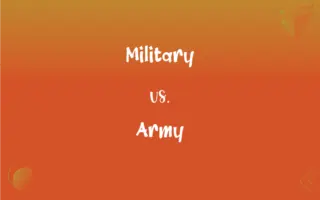Microcredit vs. Microfinance: What's the Difference?
Edited by Aimie Carlson || By Janet White || Published on November 6, 2023
Microcredit provides small loans to poor entrepreneurs, while Microfinance encompasses a broader range of financial services for the underserved.

Key Differences
Microcredit and Microfinance are both financial tools designed to alleviate poverty and promote economic growth in underserved communities. Microcredit specifically refers to the provision of small loans to individuals, often entrepreneurs, who lack access to traditional banking services. These loans enable them to start or expand microenterprises, boosting their income potential. On the other hand, Microfinance is a more encompassing term that covers not just credit but also savings, insurance, and other financial services geared toward the impoverished and those without access to conventional banks.
Microcredit became popularized as a means of financial inclusion, with the primary focus on giving the poor a chance to break out of their economic constraints. The principle behind Microcredit is that providing underserved individuals with small loans can empower them, fostering self-sufficiency and economic development. Conversely, Microfinance broadens this scope, recognizing that the financially marginalized need a comprehensive suite of services, from savings accounts to insurance, to effectively uplift themselves.
In practice, Microcredit involves organizations, often nonprofits or community groups, providing loans to individuals with little to no collateral. The success of Microcredit hinges on the trust that borrowers will repay, often facilitated through group lending models. Microfinance institutions (MFIs), meanwhile, operate on a broader spectrum. While they do offer microloans, they also provide other essential services like financial literacy training, savings facilities, and even microinsurance products, giving a more holistic approach to financial inclusion.
It's essential to note that while all Microcredit is a form of Microfinance, not all Microfinance is Microcredit. Microcredit is specifically about the credit aspect, the loans. Microfinance envelops a wider range of services, indicating its more expansive approach to addressing the financial needs of the underserved. Both, however, share the noble goal of reducing poverty and promoting sustainable economic growth among marginalized populations.
Comparison Chart
Primary Focus
Provides small loans to underserved individuals.
Offers a suite of financial services to the marginalized.
ADVERTISEMENT
Beneficiaries
Entrepreneurs lacking traditional banking access.
Broader audience including the poor without banking access.
Collateral
Typically none or very minimal.
Varies, but often minimal or group-based.
Services Offered
Loans.
Loans, savings, insurance, financial training, etc.
Goal
Empower individuals through credit for entrepreneurship.
Comprehensive financial inclusion and poverty alleviation.
Microcredit and Microfinance Definitions
Microcredit
A financial service targeting entrepreneurs lacking collateral for traditional loans.
Microcredit institutions often rely on trust-based lending.
ADVERTISEMENT
Microfinance
A spectrum of financial services designed for individuals without access to traditional banking.
Microfinance institutions in the region provide both loans and savings accounts.
Microcredit
Small loans offered to impoverished individuals without access to conventional banking.
With a microcredit loan, Maria started her own sewing business.
Microfinance
Holistic financial solutions, including loans, savings, and insurance for the impoverished.
Microfinance has been instrumental in promoting financial literacy in rural areas.
Microcredit
A tool for promoting self-sufficiency among economically disadvantaged people.
Microcredit has uplifted many rural communities by fostering small businesses.
Microfinance
A multifaceted approach to breaking the cycle of poverty through financial tools.
The town's transformation was driven by a microfinance institution's efforts, from loans to training sessions.
Microcredit
Loans that aim to drive economic growth in underserved areas.
Through microcredit, many farmers acquired the means to improve their agricultural practices.
Microfinance
A mechanism to foster economic growth and alleviate poverty through comprehensive financial inclusion.
With microfinance, communities not only borrowed but also learned to save and insure against risks.
Microcredit
Credit facilities emphasizing group lending and community trust.
In her village, group microcredit programs ensured everyone had a chance to start a venture.
Microfinance
Services targeting the marginalized, aiming for sustainable economic development.
Microfinance goes beyond lending, addressing a range of financial needs of the underserved.
Microcredit
The business or policy of making microloans to impoverished entrepreneurs. Also called microlending.
Microfinance
(finance) Finance that is provided to unemployed or low-income people or groups.
Microcredit
The practice of making very small loans, especially to poor people to promote self-employment; microlending.
Microcredit
A microloan.
FAQs
What is the primary goal of microcredit?
Microcredit aims to empower underserved entrepreneurs with small loans.
Is microcredit only for businesses?
While primarily for entrepreneurship, microcredit can also address personal or family needs in some cases.
Do microfinance institutions only provide loans?
No, microfinance encompasses loans, savings, insurance, and other financial services.
How do microfinance services promote economic growth?
By providing marginalized individuals with tools and knowledge to uplift themselves economically.
What's the impact of microfinance on community development?
Microfinance fosters local entrepreneurship, job creation, and financial stability, driving community growth.
How does microfinance differ from microcredit?
While microcredit focuses on loans, microfinance offers a broader range of financial services.
Are microcredit borrowers required to provide collateral?
Typically, microcredit does not require traditional collateral, relying instead on trust or group accountability.
How do microfinance institutions support financial literacy?
Many offer training sessions, workshops, and resources on money management and business skills.
Who benefits most from microfinance services?
Economically marginalized individuals and communities without access to conventional banking benefit most.
Are there risks in providing microcredit?
Yes, like all loans, there's a risk of default, but group lending models and community trust can mitigate this.
Are microcredit loans interest-free?
Not always. While rates might be lower than traditional banks, interest is typically charged to sustain the lending model.
Can microfinance help in emergencies?
Yes, some microfinance institutions offer emergency loans or insurance products to aid in crises.
Is the impact of microfinance purely economic?
While the primary focus is economic, microfinance also has social impacts, like promoting gender equality and community cohesion.
Can anyone access microcredit?
Microcredit targets those lacking access to traditional banking, often focusing on the economically disadvantaged.
Are microfinance services available globally?
Yes, microfinance institutions operate worldwide, especially in developing regions.
Why is microcredit considered a tool for empowerment?
It provides economically marginalized individuals the means to start or grow businesses, promoting self-sufficiency.
How do microfinance institutions sustain themselves?
Through interest on loans, service fees, and sometimes external funding or grants.
How do borrowers repay microcredit loans?
Repayment structures vary, but often include regular installments, sometimes facilitated by group lending models.
What challenges do microcredit borrowers face?
They might grapple with market fluctuations, unforeseen expenses, or even natural disasters affecting repayment.
Is microcredit a modern concept?
While forms of community lending have existed for ages, the modern concept of microcredit gained traction in the late 20th century.
About Author
Written by
Janet WhiteJanet White has been an esteemed writer and blogger for Difference Wiki. Holding a Master's degree in Science and Medical Journalism from the prestigious Boston University, she has consistently demonstrated her expertise and passion for her field. When she's not immersed in her work, Janet relishes her time exercising, delving into a good book, and cherishing moments with friends and family.
Edited by
Aimie CarlsonAimie Carlson, holding a master's degree in English literature, is a fervent English language enthusiast. She lends her writing talents to Difference Wiki, a prominent website that specializes in comparisons, offering readers insightful analyses that both captivate and inform.






































































